When any dry plant material or seeds are kept in water, they swell up.
Q(b)Define this phenomenon.
Step-by-Step Solution:
1. Understanding the Phenomenon: When dry plant materials or seeds are placed in water, they absorb water and increase in size.
2. Defining the Process: This process of water absorption by dry plant materials or seeds is called "imbibition."
3. Nature of Imbibition: Imbibition is a special type of diffusion. In this context, diffusion refers to the movement of water molecules from an area of higher concentration (the water) to an area of lower concentration (the dry seeds or plant materials).
4. Meaning of Imbibition: The term "imbibition" comes from the Latin word meaning "to drink." Thus, we can think of seeds or dry plant materials as "drinking" water.
5. Result of Imbibition: As the seeds or plant materials absorb water, their volume increases, leading to swelling. This swelling is due to the water being absorbed by the solids and colloids present in the seeds or plant materials.
6. Examples of Imbibition:
- Seeds absorbing water.
- Dry wood absorbing moisture.
- Raisins swelling up when soaked in water.
7. Conclusion: Therefore, the phenomenon where dry plant materials or seeds swell up when kept in water is defined as "imbibition."
---
- Seeds absorbing water.
- Dry wood absorbing moisture.
- Raisins swelling up when soaked in water.
Topper's Solved these Questions
- TRANSPORT IN PLANTS Book:VMC MODULES ENGLISHChapter:TRANSPORT IN PLANTS Exercise:SOLVED EXAMPLES
Explore 21 Videos
- TRANSPORT IN PLANTS Book:VMC MODULES ENGLISHChapter:TRANSPORT IN PLANTS Exercise:PRACTICE EXERCISE-(1)
Explore 5 Videos
- THE LIVING WORLD Book:VMC MODULES ENGLISHChapter:THE LIVING WORLD Exercise:CHAPTER EXERCISE-D
Explore 9 Videos
Similar Questions
When any dry plant material or seeds are kept in water, they swell up.
Q (a) Name the phenomenon involved in this change.
View SolutionWhen any dry plant material or seeds are kept in water, they swell up.
Q (c) Give two conditions essential for the phenomenon to occur.
View SolutionA cell swells up when kept in
View SolutionThe diagram below shows two test-tubes A and B. Test-tube A contains a green water plant Test-tube B contains both a green water plant and a snail. Both test tubes are kept in sunlight Answer the questions that follow
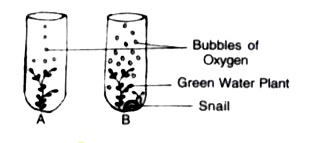
What is the purpose of keeping a snail in test-tube "B?
View SolutionThe diagram below shows two test-tubes A and B. Test-tube A contains a green water plant. Test-tube B contains both a green water plant and a snail. Both Test-tubes are kept in sunlight. Answer the questions that follow :
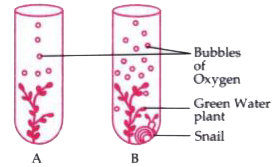
Name the physiological process that releases the bubbles of oxygen.
View SolutionThe diagram below shows two test-tubos A and B. Test-tube A contains a green water plant Test-tube B contains both a green water plant and a snail. Both test tubes are kept in sunlight Answer the questions that follow
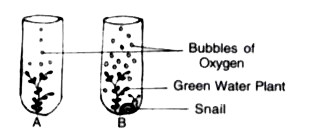
Name the physiological process that releases the bubbles of oxygen
View SolutionThe diagram below shows two test-tubes A and B. Test-tube A contains a green water plant Test-tube B contains both a green water plant and a snail. Both test tubes are kept in sunlight Answer the questions that follow
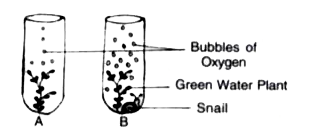
Explain the physiological process as mentioned above
View SolutionThe diagram below shows two test-tubes A and B. Test-tube A contains a green water plant Test-tube B contains both a green water plant and a snail. Both test tubes are kept in sunlight Answer the questions that follow
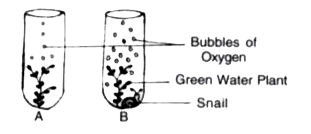
Write the overall chemical reaction for the above process.
View SolutionThe diagram below shows two test-tubos A and B. Test-tube A contains a green water plant Test-tube B contains both a groen water plant and a snail. Both test tubes are kept n sunlight Answer the questions that follow
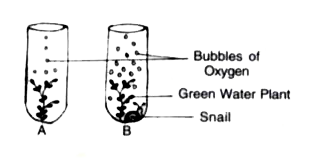
Give an example of a water plant that can be used in the above experiment.
View SolutionThe diagram below shows two test-tubos A and B. Test-tube A contains a green water plant Test-tube B contains both a groen water plant and a snail. Both test tubes are kept n sunlight Answer the questions that follow
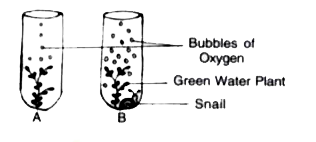
Why does test-tube 'B' have more bubbles of oxygen
View Solution
